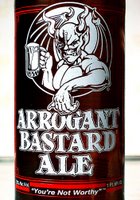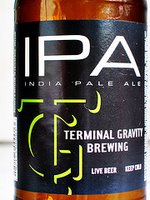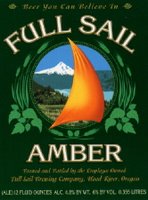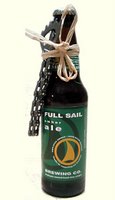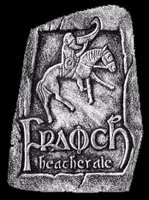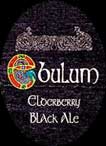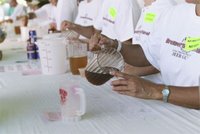This may come as a shocker to Stumptowners, but there is actually another Portland in the US. Originally known as Machigonne, it was settled in 1632 by the English as a fishing settlement. Some years later, it became "Casco" (for the city's bay) and then "Falmouth" before landing on Portland. Had New Englanders managed to get out to Oregon a couple hundred years earlier, who knows--we might be proud Falmouthers, with none of the subsequent (and now mostly vanished) confusion the two Portlands caused each other.
There are a number of similarity in the cities--but, since this is a specialized blog, I'll confine myself to beer. Much as in Oregon, there is a thriving market for micros in Maine. The state, with a population of just 1.2 million, has 25 breweries. Portland, with just 63,000 people, has eight. When you go to a pub (which look a lot like English-influenced Oregon pubs), you'll find a number of local taps. When I went into the supermarket to buy beers for review, there were perhaps a dozen local offerings (making my decision difficult). And when you go to the airport, there's a local brewpub--Shipyard--offering fresh pints. The beers are mostly British-influenced ales, and are tastier, more robust, and hoppier than any region outside West Coast.
Enough preamble--to the beers!
Geary's Autumn Ale
DL Geary is Maine's oldest brewery, and one of its best. (In fact, it's the oldest micro east of the Mississippi.) In my visits to Maine, I've had most of their beer, and was impressed especially by the pale ale. Thus did I look forward to their interpretation of a nut brown. It's not a bad effort, but it unfortunately lacks transcendence. It looks great--tawny brown, bright, with a nice roasty aroma. It's meaty, too, like too few browns, but the flavor misses the mark. It's slightly too bitter and not malty or sweet enough. Fine, but the wrong balance, neither sprightly and aggressive nor comforting. If you're in Maine, try the Pale Ale. (Two row English malt, clarity, crystal, chocolate and wheat; Cascade, Golding & Fuggle hops 5.8% abv)
Rating: Average.
D.L. Geary Brewing Company, Portland, ME
Brewer: David Geary
Founded: 1986
Beers: Pale, London Porter, Autumn Ale (nut brown), Hampshire Ale (winter warmer), Winter Ale (IPA), Summer Ale (kolsh).
Available: New England and the Northeast
Web: Gearybrewing.com
Shipyard - Blue Fin Stout
Pours black with dramatic effervescence--and a fluffy brown head. The aroma, of rich chocolate, is delightful but misleading--as you discover with the first sip, which has not the hint of sweetness. It's a bit like smelling baker's chocolate. It is a wonderful beer, thick and dense, highlighted by the strongest roasted barley I've tasted in a stout. It produces a earthy, rooty darkness on the palate that is intense like coffee, though more akin to chicory or even beets. (Hard to claim that beets taste good in beer, but here the note is delightful.) It was a beer brewed to cut through the harshest North Atlantic winds (and they are harsh). I've never had a stout like it, and I regret I have to travel 3,000 miles to get more.
Rating: A Classic.
Shipyard - IPA
Classic cloudy golden hue, with a rather weak head. Spicy aroma with a slightly bicarbinate note. Hopped solely with the classic English hop Fuggle. The flavor is a little weak for an IPA--as is the strength. It's a nice beer, with the Fuggles imparting a spicy, soapy quality. (Interestingly, though I found it to be only mildly bitter, Sally thought it was harshly so--more evidence of how bitter perception is variable.) There is little malt quality except for a pleasant, residual sweetness. Worth trying for the Fuggles, but not an exceptional beer. 5.8% abv
Rating: Average.
Shipyard Brewing Company, Portland, ME
Brewer: Alan Pugsley
Founded: 1992
Beers: Fourteen, including flagship Export and a range of mostly English ales.
Available: Throughout Southern Maine (sorry, Webfeet!)
Web: Shipyard.com
Allagash White
Cloudy, classic white head. One of the whitish whites I've seen--like unfiltered pear juice. Nice crisp aroma with the suggestion of coriander without cloying. Palate tends toward the light and dry. The spicing is modest, producing a more vinous interpretation of the style. A great choice for a brewery's first beer (as this was)--I expect it has found its way into the coolers of many of the vacationers across "Vacationland." 5% abv
Rating: Good.
Allagash Brewing Company, Portland, ME
Brewer: Rob Tod
Founded: 1995
Beers: White, Dubbel, Tripel, Grand Cru, Four, specialty and barrel-aged beers.
Available: Belmont Station
Web: Allagash.com
Casco Bay Oktoberfest
Honey-amber with a brief, light head. Oktoberfests usually have understated aromas, and so does Casco Bay--just a bit of Munich malt and a hint of floral hops. The palate is delightful--rounded and creamy, subtley sweet, and a long, spicy finish. The brewery uses a special Munich yeast for the beer, and it pays dividends--a great beer.
Rating: Excellent.
Casco Bay Brewing Company, Portland, ME
Brewer: Bryan Smith
Founded: 1994
Beers: Casco Bay: Red, Pale, Summer, Winter, Oktoberfest; Carrabassett: Pale, Brown, Winter, Summer
Available: Five states outside Maine--none closer than Ohio.
Web: Cascobaybrewing.com

